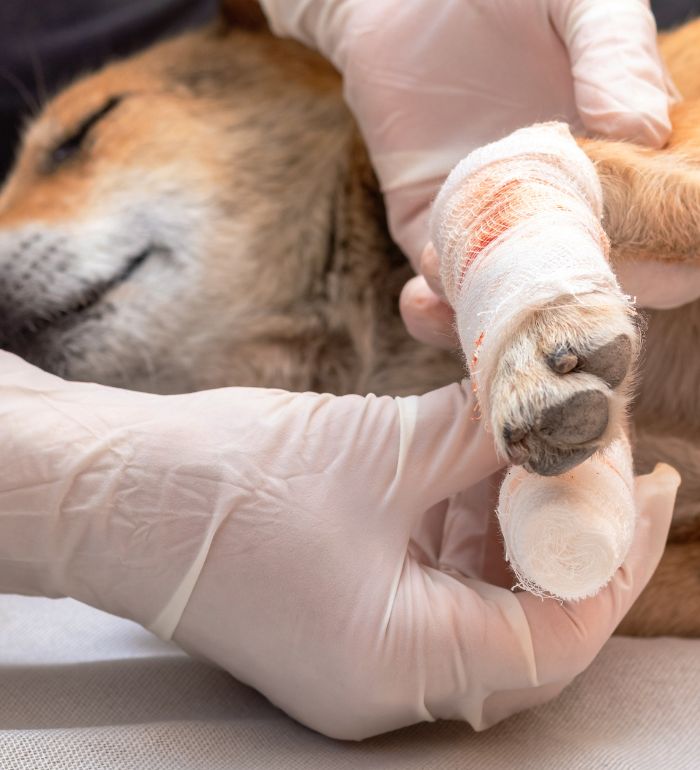Veterinary Service
Pet Orthopedic Surgeries
Several orthopedic procedures are available at Oakdale Veterinary Center. Orthopedic conditions include those that affect your pet’s bones, joints, muscles, tendons, ligaments, and the skeletal system and extremities. The mood and quality of life of your pet can be impacted by orthopedic injuries.
Pet Orthopedic Surgeries in Canton, IL
Oakdale Veterinary Center has performed a variety of orthopedic surgeries. If you require one of our surgeries, please contact us to schedule an appointment.
Pet Orthopedic Surgeries
Pets, like humans, can develop orthopedic problems that cause pain and mobility issues. Trauma, hereditary conditions, degenerative disorders, and a variety of other factors can all contribute to these issues. A variety of surgical techniques are available to restore these animals’ physical function. We provide orthopedic care for pets at Oakdale Veterinary Center.
Pet fights, falls, and car accidents can all result in fractures in cats and dogs. For the proper repair of many of these fractures, advanced surgical methods are required. Some breeds are more genetically predisposed to developing conditions like hip dysplasia, elbow dysplasia, spinal injury/disc rupture, patellar luxation, or other joint-related problems that need to be surgically corrected to function at their best. A surgeon must have extensive surgical training, experience, and the right equipment in order to produce the best results.
Cranial Cruciate Ligament Rupture
The condition that causes the cruciate ligament to tear or rupture is frequently referred to as cranial cruciate ligament disease. The underlying cause, a multimodal disease process that may include anatomical variations and the slope of the tibial tuberosity, is not fully understood. Ligament deterioration, obesity, poor physical condition, genetics, conformation, and breed are additional contributing factors. The disease cruciate disease is frequently associated with large breed dogs. Large breed dogs are more common, but small and medium-sized dogs are frequently impacted as well.
About 40–60% of dogs who tear one cruciate ligament may also tear the other because this is a degenerative condition. Within two years, on average, this happens.
A combination of physical exam results and knee radiographs (x-rays) can be used to diagnose cruciate tears. An examination of the ligament during surgery helps to confirm the diagnosis. Both arthroscopy and arthrotomy can be used to accomplish this.
Dogs with cruciate tears can receive a variety of surgical treatments. The Tibial Plateau Leveling Osteotomy has been demonstrated to have the best short- and long-term results (TPLO). Through this procedure, the abnormal motion in the knee brought on by the cruciate tear is completely eliminated by a reduction in the tibial slope.
Medial Patellar Luxation (MPL)
Young dogs of small breeds are frequently found to have patellar luxation, but large-breed dogs can also develop this condition. Despite the possibility of patellar luxation, surgery may not be necessary for your pet.
In patients who have persistent pain and lameness as a result of the luxation, we advise correcting the patellar luxation. Your dog might skip or hold up the affected leg while moving around or running. To put the patella back in its proper place, they might also stretch the leg backward.
Hip Dysplasia
The most common cases of hip dysplasia in dogs are those of large breeds. Increased hip joint laxity is the first sign of this developmental disorder, which progresses to abnormal joint articulation and wear of the joint surfaces. As the dog ages, this results in the development of arthritis, which can make it painful and challenging for the dog to stand up, run, jump, and play as they did before.
Elbow Dysplasia
Large breed dogs (Labrador retrievers, Golden retrievers, Rottweilers, German Shepherds, Newfoundlands, and Bernese Mountain dogs) are frequently diagnosed with elbow dysplasia, which has several different manifestations (Medial Coronoid Disease (MCD), Osteochondritis Dessicans (OCD), and Ununited Anconeal Process) (UAP).
One or more of the symptoms of this condition can affect dogs. In the majority of cases, it is possible to treat it arthroscopically, which reduces the postoperative pain and recovery time while minimizing the surgical trauma associated with a significant incision into the joint.
Shoulder Disorders
Osteochondritis Dessicans is the most prevalent condition that is treated with the dog's shoulder (OCD). This is frequently observed in young large breed dogs and is brought on by an anomaly in the cartilage's growth within the shoulder joint. Due to this abnormal growth, the cartilage thickens and eventually separates from the underlying bone, forming a cartilage flap.
In order to treat this condition, the fragment must be taken out, and the underlying bone must be cleaned up to promote fibrocartilage formation. Most frequently, arthroscopic surgery is used for this procedure, which reduces the amount of time needed for surgery, postoperative pain, and recovery.
The majority of patients can leave the hospital on the day of surgery.
Patients who receive treatment for shoulder OCD have a very good prognosis.
Another painful shoulder condition that can be identified and treated arthroscopically is biceps tenosynovitis. It might happen as a result of joint trauma or a soft tissue injury sustained during strenuous activity. It is typically painful to palpate over the biceps tendon, and a physical exam can frequently identify it.
Veterinary Services in Canton, IL
Soft Tissue Surgery
Cold Laser Therapy
Dental Care
Boarding
Radiology
Orthopedic Surgeries
Puppy & Kitten Care
Laboratory Services
Parasite Prevention
Euthanasia & Cremation
Surgical Laser
Wellness Exams
Microchipping
Ultrasound

